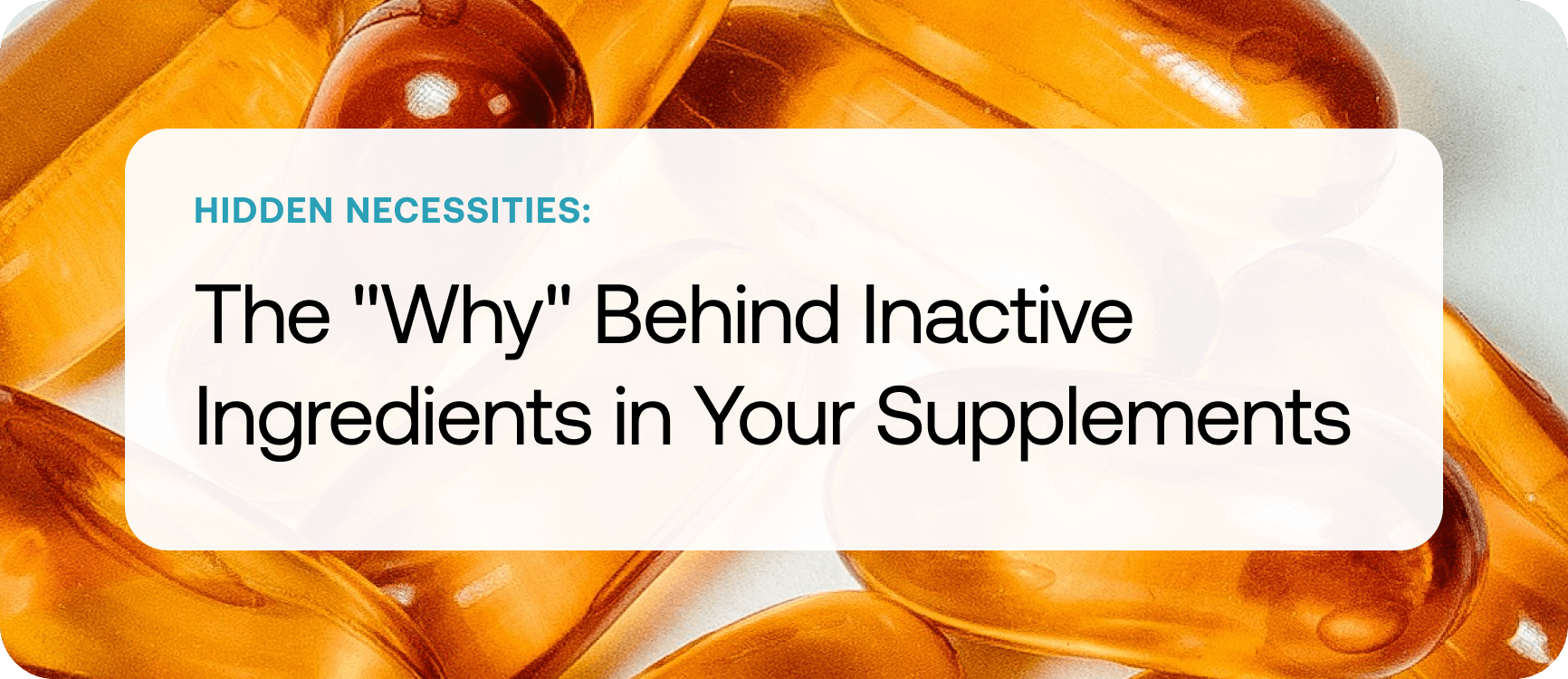Science Corner 02 | The "Why" Behind Inactive Ingredients in Your Supplements
In a supplement world where marketing magic often outshines science, we’re here to cut through the noise. Each week, we’ll translate complex research into bite-sized insights about what's actually in your supplements and how they interact with your body.
No hype, buzzwords or exaggerated claims; our simple promise to you is straightforward science that helps you make better choices. Because at SuppCo, we believe supplements should work for you, not the other way around.

Hidden Necessities:
The "Why" Behind Inactive Ingredients in Your Supplements
Have you ever stood in the supplement aisle, bottle in hand, squinting at what seemed like a chemistry experiment listed under "Other Ingredients"? That moment of label-reading confusion is one we've all experienced.
Years and much research later, I've come to appreciate these supporting characters in the supplement story. They aren't villains diluting your wellness investment—they're more like the backstage crew making sure the star of the show actually performs.
Let's pull back the curtain on these misunderstood ingredients:
Binders: The Necessary Glue
Binders like microcrystalline cellulose, acacia gum, and cellulose gel help active ingredients stick together to form a solid tablet. Without them, your supplements would crumble before they made it to the bottle.
Quality Check: Not all binders are created equal. Plant-based options like cellulose derivatives are generally well-tolerated, while synthetic polymers like polyvinylpyrrolidone (PVP) represent the more highly processed end of the spectrum. When possible, look for recognizable plant-based binders.
Fillers: More Than Empty Space
The term "filler" has gotten a bad rap, but ingredients like calcium phosphate, lactose, and rice flour serve important functions—adding necessary bulk, improving manufacturing consistency, and ensuring accurate dosing of potent ingredients.
I think of fillers like the rice in a stir-fry. They may not be the star, but they help distribute the powerful flavors evenly throughout the dish.
The Minimalist Question: When Less Is More
Take creatine monohydrate—some high-quality options contain just creatine, while others list five or six inactive ingredients. Why?
Format matters. Pure powders can often stand alone, while tablets and capsules require additional ingredients for stability. But sometimes, it's also about cost-cutting or marketing appeal.
Here’s how to tell the difference:
Does the format actually require these additives?
Is the active ingredient naturally stable?
Are there more inactives listed than active ingredients?
Does the company explain why each inactive is included?
The answers reveal whether you're seeing necessary helpers or unnecessary fillers.
Lubricants: Necessary Evil?
Here's where healthy skepticism is warranted. Lubricants prevent ingredients from sticking to manufacturing equipment, but they're often overused.
While many companies proudly advertise avoiding controversial magnesium stearate, they've simply switched to alternatives like rice concentrate, ascorbyl palmitate, or vegetable stearic acid. Premium brands often use minimal lubricants or find innovative ways to reduce their necessity—reflecting a commitment to quality over convenience.
Preservatives: Guardians of Potency
Many botanicals would quickly degrade without preservatives like rosemary extract, ascorbic acid (vitamin C), or tocopherols (vitamin E). I once tried completely preservative-free supplements that developed an off-putting smell within months, well before their expiration date.
Nature vs. Chemistry: Look for naturally-derived options rather than synthetic alternatives like BHT, sodium benzoate, or potassium sorbate. The difference impacts not just efficacy but also how your body processes the supplement.
Flow Agents: Keeping Things Moving
Silicon dioxide, calcium silicate, and tricalcium phosphate might not sound appetizing, but these flow agents prevent ingredients from clumping together during manufacturing. They ensure consistency of the powder blends, which translates to consistent dosing in each tablet or capsule.
Coating Agents: Beauty at a Cost
Coatings like hydroxypropyl methylcellulose, shellac, and titanium dioxide make supplements more visually appealing, mask bitter tastes, and make tablets easier to swallow. But artificial colors deserve our skepticism.
FD&C colors (like Blue No. 1 or Red No. 40) have come under increasing scrutiny, with research suggesting possible connections to behavioral issues and hypersensitivity reactions in some individuals.
Do I really need my calcium tablet to be sunshine yellow? The trend toward natural, undyed supplements reflects growing awareness that beautiful pills aren't necessarily better pills.
Good alternatives do exist. Companies like Hilma are leading the way with products such as their Fiber Gummy, which uses natural colors derived from fruits and vegetables instead of artificial dyes. This proves that supplements can maintain visual appeal while avoiding potentially problematic synthetic additives.

The Takeaway
The best supplement companies use inactive ingredients mindfully, including only what's necessary and choosing the least processed, most biocompatible options available.
While it's wise to choose supplements with thoughtfully selected inactive ingredients, understanding their purpose helps us make informed choices rather than fearful ones. After all, wellness isn't just about what we put in our bodies—it's also about the knowledge behind those choices.
Stay tuned next week for specific guidance on which inactive ingredients to embrace and which to avoid. And check out our new excipient feature, where we provide ratings for inactive ingredients across 125,000+ products in our database.
